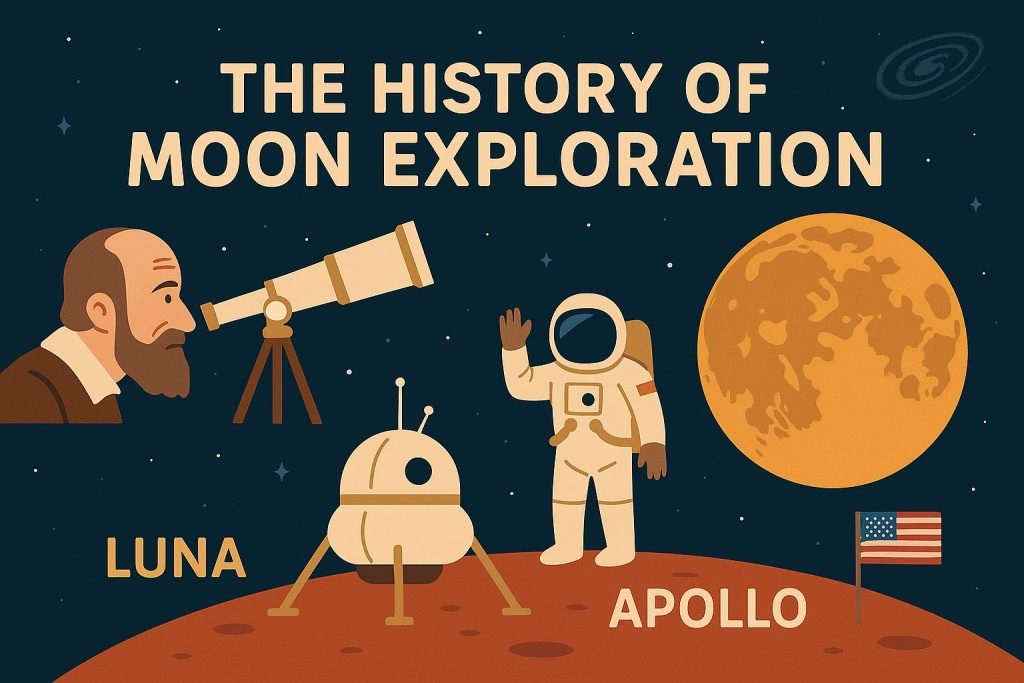The Moon, Earth’s closest celestial neighbor, has fascinated humanity since ancient times. For centuries, it was the subject of myths, calendars, and early astronomical observations. But in the last century, it became the first extraterrestrial body to be explored by spacecraft and visited by humans. The history of Moon exploration is not only a triumph of science and technology but also a tale of ambition, rivalry, and discovery.
From early telescopic sketches to robotic missions and human landings, our understanding of the Moon has expanded dramatically.
Ancient Observations to the Telescope Age
Long before spaceflight, ancient civilizations tracked the lunar cycle, using it to structure calendars and religious observances. The Moon’s phases, eclipses, and surface markings were studied in Babylon, Egypt, Greece, and China.
In 1609, Galileo Galilei became the first person to observe the Moon through a telescope. His drawings revealed craters, mountains, and a rugged terrain—disproving the belief that the Moon was a smooth, perfect sphere.
This marked the start of scientific lunar observation.
The Space Race and the First Probes
In the 1950s and 60s, the Cold War fueled the space race between the United States and the Soviet Union. The Soviet Luna program made history in 1959 when Luna 2 became the first human-made object to impact the Moon. Shortly after, Luna 3 photographed the Moon’s far side for the first time.
The U.S. responded with the Ranger and Surveyor programs, which sent robotic probes to crash-land or soft-land on the Moon to gather surface data. These missions paved the way for human exploration.
Apollo and the Human Landings
The peak of Moon exploration came with NASA’s Apollo program. After years of preparation, Apollo 11 made history on July 20, 1969, when Neil Armstrong became the first human to step onto the Moon, followed by Buzz Aldrin.
In total, six Apollo missions (11, 12, 14, 15, 16, and 17) successfully landed humans on the Moon between 1969 and 1972. They:
- Collected over 380 kg of lunar rock
- Deployed scientific instruments
- Conducted geological surveys
- Used the Lunar Roving Vehicle to travel long distances
Apollo 17 in 1972 marked the last human mission to the Moon—until the 21st century.
Post-Apollo Robotic Missions
After Apollo, Moon exploration continued with orbiters, rovers, and impact missions from different countries:
- Clementine (1994) and Lunar Prospector (1998) mapped lunar resources
- SMART-1 (ESA), Kaguya (Japan), Chandrayaan-1 (India), and Chang’e missions (China) brought global attention back to the Moon
- Lunar Reconnaissance Orbiter (NASA, 2009–present) is still mapping the Moon in high detail
China’s Chang’e 4 made history in 2019 by becoming the first mission to land on the far side of the Moon.
The Future: Return and Beyond
Today, Moon exploration is entering a new golden age. NASA’s Artemis program aims to return humans to the Moon by the mid-2020s, including the first woman and first person of color. Plans include building the Lunar Gateway, a space station orbiting the Moon, and eventually establishing a sustainable base.
Private companies like SpaceX, Blue Origin, and international space agencies are preparing robotic and crewed missions to explore lunar resources and prepare for Mars.
The Moon is no longer just a symbol of past achievement—it is a gateway to deeper space exploration.
Glossary
- Lunar cycle – the progression of the Moon’s phases over about 29.5 days
- Luna program – Soviet missions to the Moon (1959–1976)
- Apollo program – U.S. NASA missions that landed humans on the Moon
- Orbiter – a spacecraft that circles a planet or moon without landing
- Lunar Gateway – planned Moon-orbiting space station by NASA and partners
- Chang’e missions – Chinese lunar missions named after a moon goddess


